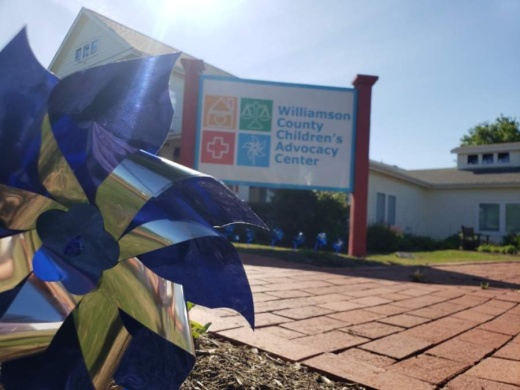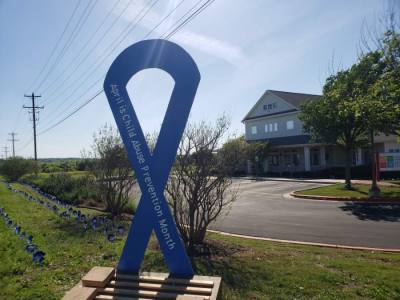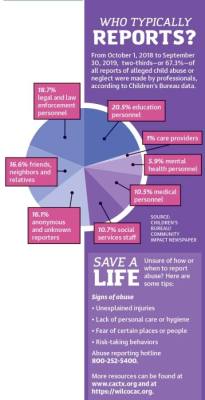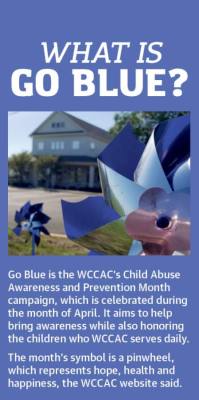Williamson County Children’s Advocacy Center CEO Kerrie Stannell said where the center usually receives an average of 20-30 reports of child abuse in the county a day, they are now receiving an average of 8-10.
The center provides assistance to children who have experienced physical or sexual abuse. As a nonprofit, the center works with law enforcement, child protective service professionals and the county’s district attorney to minimize trauma for survivors of abuse while other agencies conduct criminal investigations.
Child abuse has always been an issue, Stannell said, and with children away from their number one reporter of abuse, she knows abuse is still happening, just not being reported. But most of all, she fears in the current climate it could get worse.
“The problem before [the coronavirus pandemic] was big,” Stannell said. “So I hope we don't see this amplified to any degree.”
The Children’s Advocacy Centers of Texas represents 71 CACs in the state serving 210 of the 254 counties in Texas. According to statistics by the organization, 175 Texas children are the victims of abuse every day. In addition, 1 in 10 children will be sexually abused before their 18th birthday. With 7.4 million children residing in Texas, this would equal 740,000 child victims of abuse—without a global pandemic changing life in every aspect.
Stannell said she fears the impacts from the coronavirus pandemic will increase stressors that could lead to more child abuse: Families are bound inside together all day. Parents are now teachers as well as providers and caregivers, often with few or no breaks. Some may have even lost financial stability, whether through a job or loss in investments.
Stannell said she fears these factors will play a role in more child abuse occurring. But her biggest concern is for children stuck at home with their abusers, as 90% of child abuse victims know their abusers.
“Physical abuse, we will really see amp up in times of extreme stress and pressure,” Stannell said. “[But] we're really nervous about the kids that are suffering from sexual abuse. They're home with their abusers, and they're stuck in one place, so they can't tell anyone and they can't get away from that situation.”
Christina Green, chief advancement officer of the CACs of Texas, said in the state of Texas 60%-70% of child abuse is sexual. Followed by severe physical abuse.
She reiterated Stannell fears.
“A lot of times we think about stranger danger, and that is someone outside the home,” Green said. “But a lot of times—actually the majority of the time—the child knows who the alleged perpetrator is and it is oftentimes a family member or someone in the home.”
Drops in reporting
According to the CACs of Texas, the number of statewide intake reports have dropped from an average of 1,500-1,600 in the month of March to less than 1,000, citing coronavirus as the driving factor.
Green said children not attending school or daycare, going to doctor appointments or participating in after school programs has impacted the number of reports, as these outside adults drive more than two-thirds of child abuse reports.
“Reporting is going down, but we know [abuse] is still happening,” Green said.
For Williamson County, the number of reports dropped from 407 in March 219 to 364 in March 2020—or by 10.57%. However, the center still interviewed about the same number of victims year over year, conducting 68 in March 2019 and 65 in March 2020.
WCCAC Director of Community Engagement Tiffany Sturman said this is because of the virus. The center saw a higher numbers of reports in early March 2020 versus March 2019, but because there has been a reduction in reporting in mid- to late-March, the number of interviews conducted also dropped, she said. Sturman said if the pandemic did not occur, the center was on track to conduct many more interviews in March 2020 than in March 2019.
She added while the numbers are down in March, she fears the number of reports will be even lower in April when children are home for an entire month.
On March 31, Georgetown ISD announced it would extend its closure from April 13 to at least May 4 to reduce the spread of coronavirus. On April 17, Texas officials announced schools would stay closed for the rest of the semester.
“I anticipate the next two weeks will start to show the more drastic trend,” Sturman said in an April 2 email to Community Impact Newspaper.
Green said it is common for reports to go down when children are not in school for summer or holiday breaks because teachers are prominent reporters. She added that this is also the case during times of economic downturns and natural disasters.
She added that with coronavirus, statewide reports are down on average about 25% but it can be as high as 50%-75% in some parts of the state depending on how restrictive movement is in certain communities.
“Whenever kids are not in school or with other adults outside the home, we see reports go down, but we know that abuse is still happening if not increasing in incidence and severity,” Green said.
Shedding a light
April is National Child Abuse Awareness and Prevention Month. For it, the WCCAC’s Go Blue campaign works to bring awareness to the issue in the area.While many of the events initially scheduled to promote awareness have been postponed or moved to virtual platforms, Stannell said the mission is the same: ending child abuse.
“Child abuse is a much bigger problem than people really understand and we want people to really talk about it and know what it looks like,” Stannell said. “Ending child abuse is the main goal.”
The Go Blue! Committee is made of WCCAC, Leander Police Department, Georgetown PD, Cedar Park PD, The Georgetown Project, CASA of Williamson County, Round Rock PD, Bikers Against Child Abuse, Williamson County Juvenile Services and Williamson County Sheriff’s Office.
Its national symbol is the pinwheel, which represents hope, health and happiness, the WCCAC website said.
“The pinwheels serve as a reminder that we all have a responsibility to create communities that promote healthy environments for children,” it said.
Helpful tips
With children not seeing teachers, sport coaches, medical professionals and other trusted adults outside of their home, Stannell asks that neighbors and community members fill the void and look out for signs of abuse.
Stannell asked that neighbors and community members follow their gut instincts if they believe abuse is happening.
“With the crime of child abuse, it is very important to realize that these are the crimes that children are never going to call out for themselves,” Stannell said. “Even though this is happening in someone's home, their children still need advocates and they still need someone looking out for them.”
Some common signs of child abuse, according to the Texas Department of Family and Protective Services, include frequent injuries such as bruises, cuts, black eyes or burns without adequate explanations; frequent complaints of pain without obvious injury; aggressive, disruptive, and destructive behavior; unreasonable clothing that may hide injuries to arms or legs; lack of personal cleanliness; or torn or dirty clothing. Additional signs of child abuse can be found at www.dfps.state.tx.us. The website also offers other helpful tips on 24/7 parenting during the coronavirus pandemic.
For stressed parents, the organization Help for Parents and Hope for Kids suggests parents go for walks outside, take warm baths or showers and call a friend to talk and laugh. More helpful tips can be found at www.helpandhope.org.
“We are all currently facing uncharted waters due to the coronavirus outbreak,” the Help and Hope website reads. “These changes to how families live, work, go to school and play are occurring rapidly and they are hard. Even at the best of times, change creates stress. It is more important than ever that we have realistic expectations about what all of these changes mean for our current daily lives and pay attention to how they are impacting our families.”
She added while the numbers are down in March, she fears the number of reports will be even lower in April when children are home for an entire month.
On March 31, Georgetown ISD announced it would extend its closure from April 13 to at least May 4 to reduce the spread of coronavirus. On April 17, Texas officials announced schools would stay closed for the rest of the semester.
“I anticipate the next two weeks will start to show the more drastic trend,” Sturman said in an April 2 email to Community Impact Newspaper.
Green said it is common for reports to go down when children are not in school for summer or holiday breaks because teachers are prominent reporters. She added that this is also the case during times of economic downturns and natural disasters.
She added that with coronavirus, statewide reports are down on average about 25% but it can be as high as 50%-75% in some parts of the state depending on how restrictive movement is in certain communities.
“Whenever kids are not in school or with other adults outside the home, we see reports go down, but we know that abuse is still happening if not increasing in incidence and severity,” Green said.
Shedding a light
April is National Child Abuse Awareness and Prevention Month. For it, the WCCAC’s Go Blue campaign works to bring awareness to the issue in the area.While many of the events initially scheduled to promote awareness have been postponed or moved to virtual platforms, Stannell said the mission is the same: ending child abuse.
“Child abuse is a much bigger problem than people really understand and we want people to really talk about it and know what it looks like,” Stannell said. “Ending child abuse is the main goal.”
The Go Blue! Committee is made of WCCAC, Leander Police Department, Georgetown PD, Cedar Park PD, The Georgetown Project, CASA of Williamson County, Round Rock PD, Bikers Against Child Abuse, Williamson County Juvenile Services and Williamson County Sheriff’s Office.
Its national symbol is the pinwheel, which represents hope, health and happiness, the WCCAC website said.
“The pinwheels serve as a reminder that we all have a responsibility to create communities that promote healthy environments for children,” it said.
Helpful tips
With children not seeing teachers, sport coaches, medical professionals and other trusted adults outside of their home, Stannell asks that neighbors and community members fill the void and look out for signs of abuse.
Stannell asked that neighbors and community members follow their gut instincts if they believe abuse is happening.
“With the crime of child abuse, it is very important to realize that these are the crimes that children are never going to call out for themselves,” Stannell said. “Even though this is happening in someone's home, their children still need advocates and they still need someone looking out for them.”
Some common signs of child abuse, according to the Texas Department of Family and Protective Services, include frequent injuries such as bruises, cuts, black eyes or burns without adequate explanations; frequent complaints of pain without obvious injury; aggressive, disruptive, and destructive behavior; unreasonable clothing that may hide injuries to arms or legs; lack of personal cleanliness; or torn or dirty clothing. Additional signs of child abuse can be found at www.dfps.state.tx.us. The website also offers other helpful tips on 24/7 parenting during the coronavirus pandemic.
For stressed parents, the organization Help for Parents and Hope for Kids suggests parents go for walks outside, take warm baths or showers and call a friend to talk and laugh. More helpful tips can be found at www.helpandhope.org.
“We are all currently facing uncharted waters due to the coronavirus outbreak,” the Help and Hope website reads. “These changes to how families live, work, go to school and play are occurring rapidly and they are hard. Even at the best of times, change creates stress. It is more important than ever that we have realistic expectations about what all of these changes mean for our current daily lives and pay attention to how they are impacting our families.”









